AND A SHORTLIST OF THINGS I WISH I COULD HAVE STOLEN FROM HER DUBLIN GARDEN
 Stone sculpture of a woman against ivy, Helen Dillon’s garden.
Stone sculpture of a woman against ivy, Helen Dillon’s garden.
I am perched at Helen Dillon’s kitchen table in Ranelagh, a spreading residential area of Dublin. It is a grey August lunchtime and I am being plied with a high-energy volley of slightly startling pronouncements on the state of garden writing – as well as a welcome glass of sweet elderflower and a cheese and tomato sandwich – by the legendary gardener, trying not to get too distracted by how very beautiful a woman can be in her late 70’s.
Much to the surprise of the gardening world – and no doubt to the delight of the Dublin real estate market – this elegant Georgian house has been sold. The much visited and photographed garden, described by Robin Lane Fox in the Financial TImes as ‘the best walled town garden one can hope to see’, will finally close to the public at the end of September 2016. A steady stream of star-struck visitors – mostly civilised looking women of a certain age – arrive tentatively at the front door (you visit the garden via the elegant Georgian hallway and antique filled drawing room and hand over your five Euro note discreetly as you arrive). In the last few weeks there have been at least 200 admirers a day.
 Helen Dillon’s house, 45 Sandford Terrace, Dublin.
Helen Dillon’s house, 45 Sandford Terrace, Dublin.
45 Sandford Terrace is a place of legend. Mick Jagger once rented the house for a month whilst he was recording in Dublin and when Helen Dillon suddenly replaced the carefully manicured lawn with a contemporary reflecting pool after a visit to the Alhambra, her husband Val famously retorted that he was fine with the change as ‘grass is an ass’. The twinkly eyed chatelaine has always enjoyed delivering a little light shock to her visitors – her desire for intense colour and a certain restlessness was finally satisfied when she developed a pragmatic version of successional planting which involved plonking plastic containers of dahlias, lilies and brugmansia directly into the bed (i.e. not planting them) wherever there was a lull in the eye-popping herbaceous borders. If a bit of black plastic can be seen, so be it, feast your eyes on something else.
 Yolk yellow brugmansia with Verbena bonariensis, Helen Dillon’s garden.
Yolk yellow brugmansia with Verbena bonariensis, Helen Dillon’s garden.
 Purple salvia and electric red crocosmia, Helen Dillon’s garden.
Purple salvia and electric red crocosmia, Helen Dillon’s garden.
 One of the long borders at Helen Dillon’s garden, Lythrum salicaria (probably) ‘Feuerkerze’ and Agapanthus ‘Purple Cloud’.
One of the long borders at Helen Dillon’s garden, Lythrum salicaria (probably) ‘Feuerkerze’ and Agapanthus ‘Purple Cloud’.
The reason for her success is a tireless, passionate, no-nonsense approach to plants and to gardening – she has endlessly tried out new things, has been speedy to get rid of things which are not working, is a famous champion of other fine gardeners and has always been determined to seek out the best forms of the plants she is using. I did not have time to check the name of the bright pink loosestrife pictured above, but I am pretty sure it is ‘Feuerkerze’ which is a brilliant pink and a world apart from the cooler mauve-pink of other loosetrifes.
A couple of weeks after my visit Helen wrote a wonderfully frank piece for the Guardian Weekend magazine in which she bared all about the plants she will be taking with her to her new, almost definitely smaller, town garden and the plants she is pleased to leave behind. She is brutal about the presence of honey fungus, vine weevil and other problems which have inevitably affected her old town garden, scathing about ‘the handsome but incontinent (i.e. impossible to get rid of) self-seeding onion Nectaroscordum siculum’ and brilliantly honest about the Cestrum parqui she has grown for its famously romantic midnight perfume – confessing that it does indeed have a horrid daytime smell and that she has ‘only once been up late enough to smell it’.
But the real gold dust is her list of plants she will not fail to grow in her next garden. Although it is an avid self seeder she ‘cannot get enough of the lovely white willow herb Chamerion angustifolium ‘Album’ ‘, and her list includes Erigeron karvinskianus, the ‘charming coloniser of cracks and paving’ – which I too love for the way it softens the brick paths in my own town garden – Pulmonaria ‘Blue Ensign’ (with flowers of a particularly rich purple-blue, and the ‘lovely pale blue’ agapanthus ‘Eggesford Sky ‘. She writes: ‘ I find after collecting agapanthus for 30 years or so that the pale blue cultivars show up better from a distance than some of (the very desirable) dark colours’. I am excited that Helen Dillon is so keen on pale blue agapanthus. I have three huge pots of Agapanthus ‘Blue Ice’ which is towering and only faintly blue – I love the way that a clear, pale blue can read almost as a gentle white in a palette of soft colours.
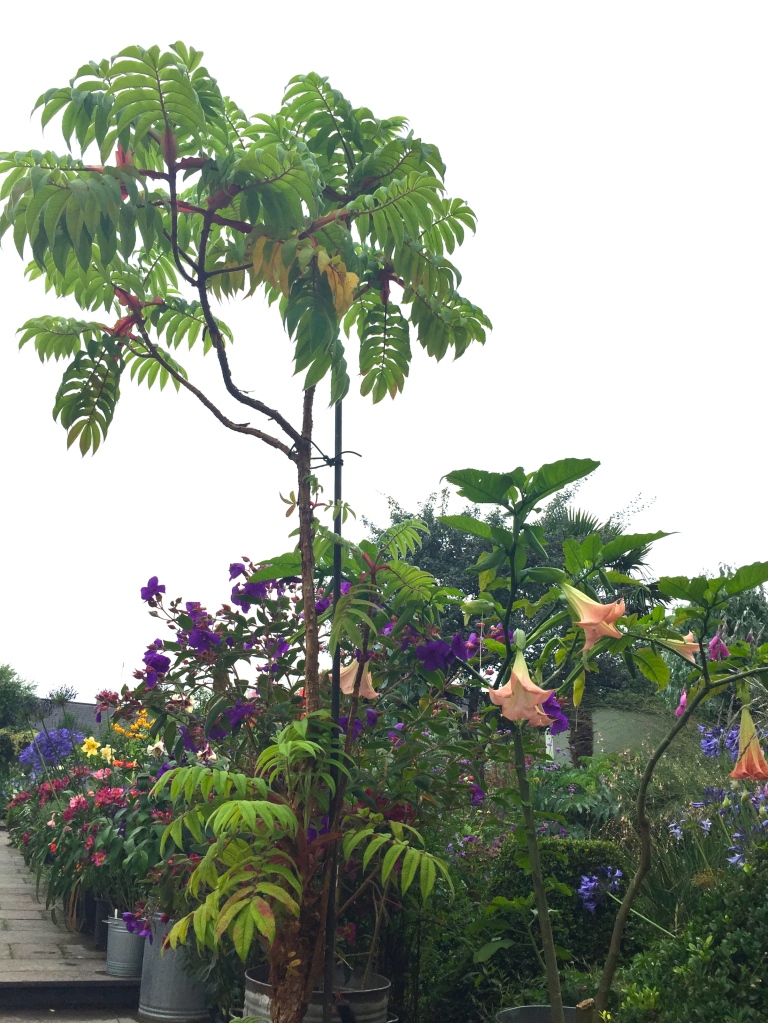
An elegant umbrella of Hagenia abyssinica, with brugmansia and Tibouchina urvilleana,, Helen Dillon’s garden.
Another plant that features in the precious Guardian list is Hagenia abyssinica ‘from the forests of Ethiopia, a superb tree for growing in a large pot (kept under glass for winter)’. This is a plant I would have been delighted to cart off in the back of my rented Skoda. I have a slight fear that we may need to head off to Ethiopia ourselves to track down a hagenia for our own gardens but they are definitely covetable. In the Dillon garden there are four pots of these elegant umbrella-like trees on the terrace next to the pool, their bright green leaves are a wonderful foil to the gorgeous salmon brugmansia trumpets (which will incidentally become heavily fragrant at a more sociable time of the evening than the Cestrum parqui) and to the velvety purple of Tibouchina urvilleana, the glory bush.
 Pale salmon brugmansia.
Pale salmon brugmansia.
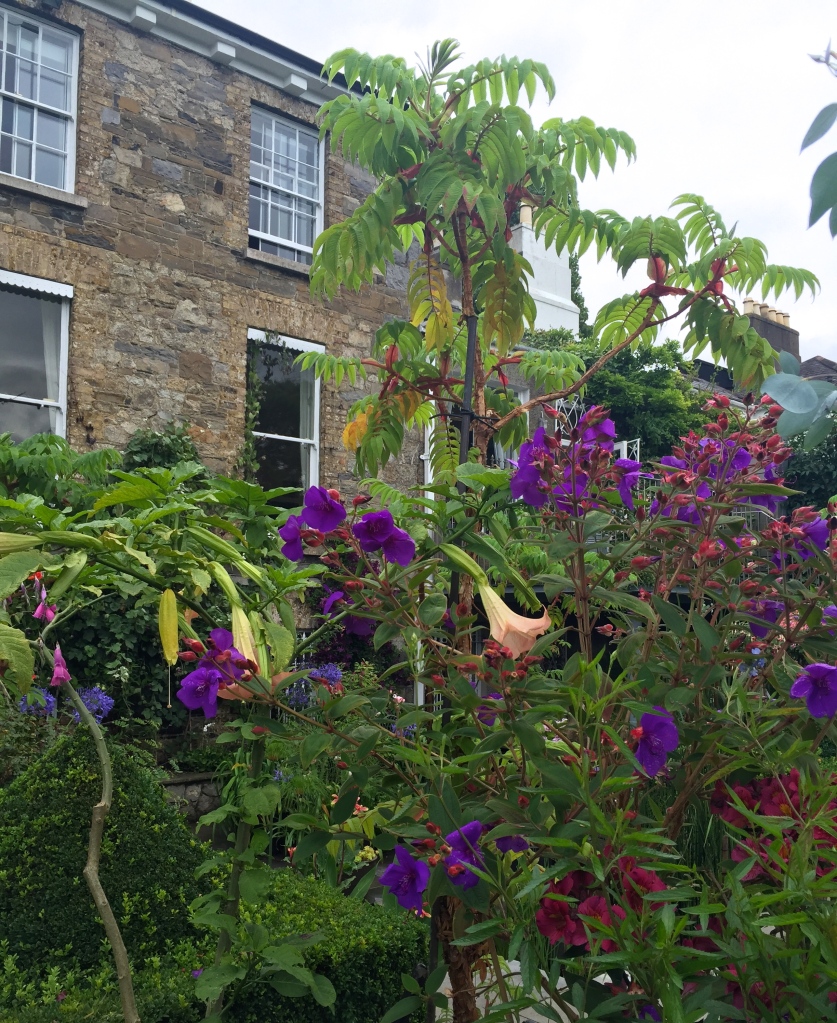 Hagenia abyssinica elegantly exotic against the more demure Georgian brickwork of the house.
Hagenia abyssinica elegantly exotic against the more demure Georgian brickwork of the house.
Helen Dillon would also take with her the ‘superb large fern’ Woodwardia unigemmata. This is a wonderful new discovery for me – with new fronds a gorgeous brick red – and goes firmly on my list of ideas to steal.
 Woodwardia unigemmata – the new fronds are a gorgeous brick red.
Woodwardia unigemmata – the new fronds are a gorgeous brick red.
The woodwardia was nestling comfortably in the shady woodland corner of the garden populated by another desirable and exotic tree, Aralia echinocaulis, grown from seed brought back by Jimi Blake, whose inspiring Hunting Brook Gardens is only about 30 miles south of Dublin. NB, Jimi and his sister June Blake – whose equally seductive garden is next door – sometimes have seedlings of these for sale.
 A skinny woodland of Aralia echinocaulis, Helen Dillon’s garden.
A skinny woodland of Aralia echinocaulis, Helen Dillon’s garden.
 Aralia echinocaulis foliage. Helen Dillon’s garden.
Aralia echinocaulis foliage. Helen Dillon’s garden.
I love this celebration of filtered light and the power of different greens in this part of the garden. This beautiful sculpture of a young girl has the perfect, timeless backdrop of light-catching ivy – even with the nearby chatter of respectful visitors the combination has an aura of stories and secrets not yet told:

Stone sculpture against ivy, Helen Dillon’s garden.
More magical still is this wonderful fuchsia, Fuchsia magellanica var. molinae, which has formed a delicate bower over the pretty iron seat laden with dart-like palest pink flowers.

Iron seat in a bower of Fuchsia magellanica var. molinae.
In the conservatory a loose-limbed palm-leaved begonia, Begonia luxuriant, looks rakish but charming against the painted brick. So keen am I to acquire a Begonia luxuriant of my own that I have tracked it down to the nursery at Great Dixter where I discover that they bed it out for the summer. Somehow the note on the nursery catalogue that it is ‘too fragile to dispatch’ makes the journey to East Sussex event more tempting.
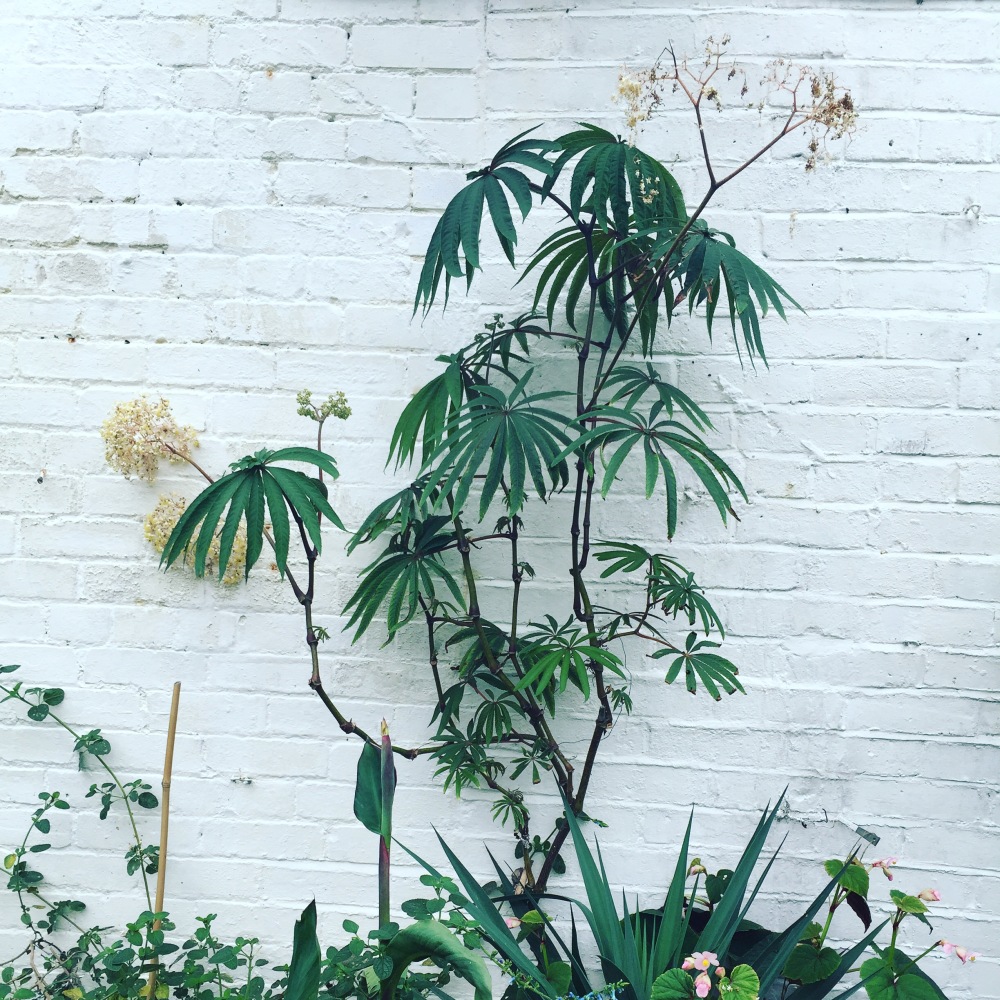
Begonia luxurians in the Conservatory, Helen Dillon’s garden.
Elsewhere in the garden I am a little less certain about the metal framed tunnel with views through to the reflecting pool and to an urn at the other end – but the framing works pretty well, maybe I am just hitting a quieter moment in the year, maybe if it was my own garden and I was about to leave it I too would be entitled to a patch or two where the garden was in a lower gear? I like the lower view best with the fennel filling and softening the frame, and the stretch of water settling and adding weight to the image.
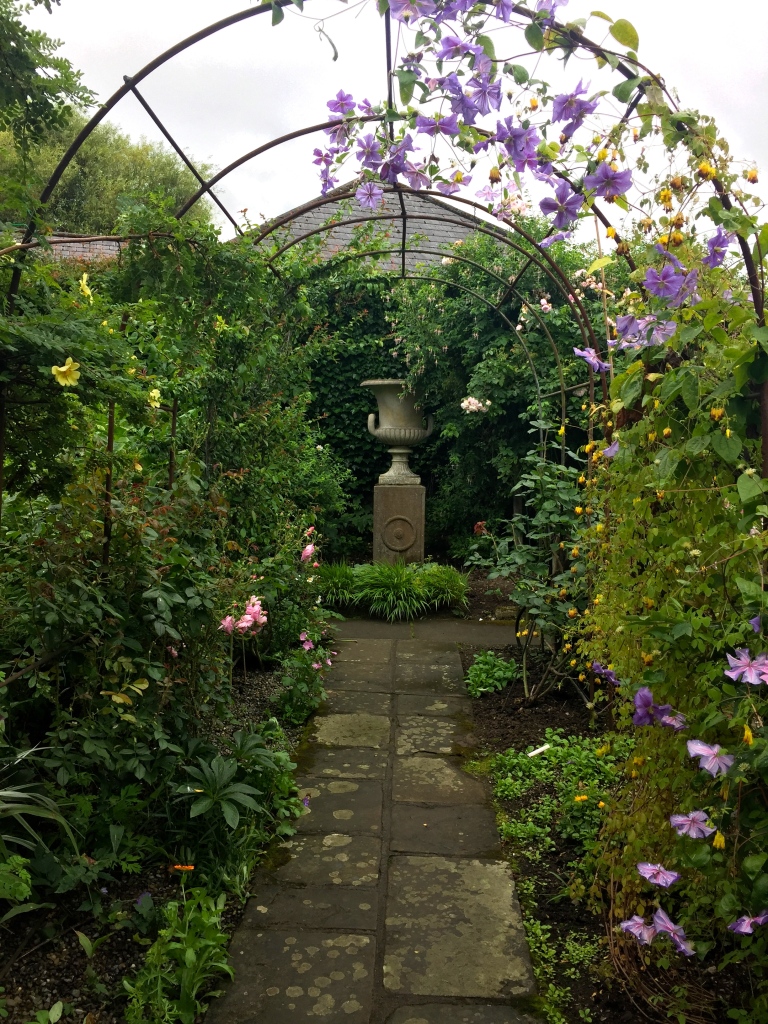
Metal arch with view to urn…

…and through to the reflecting pool.
There are of course still plenty of high octane pockets of plants apart from the colourful parade of the Long Borders. Raised beds for fruit and vegetables are jumbled up with phlox and dahlias in the happiest of ways.
 Colourful vegetable beds, Helen Dillon’s garden.
Colourful vegetable beds, Helen Dillon’s garden.
A rather dull wall is completely ignored by a stand of radiant carmine Lobelia tupa
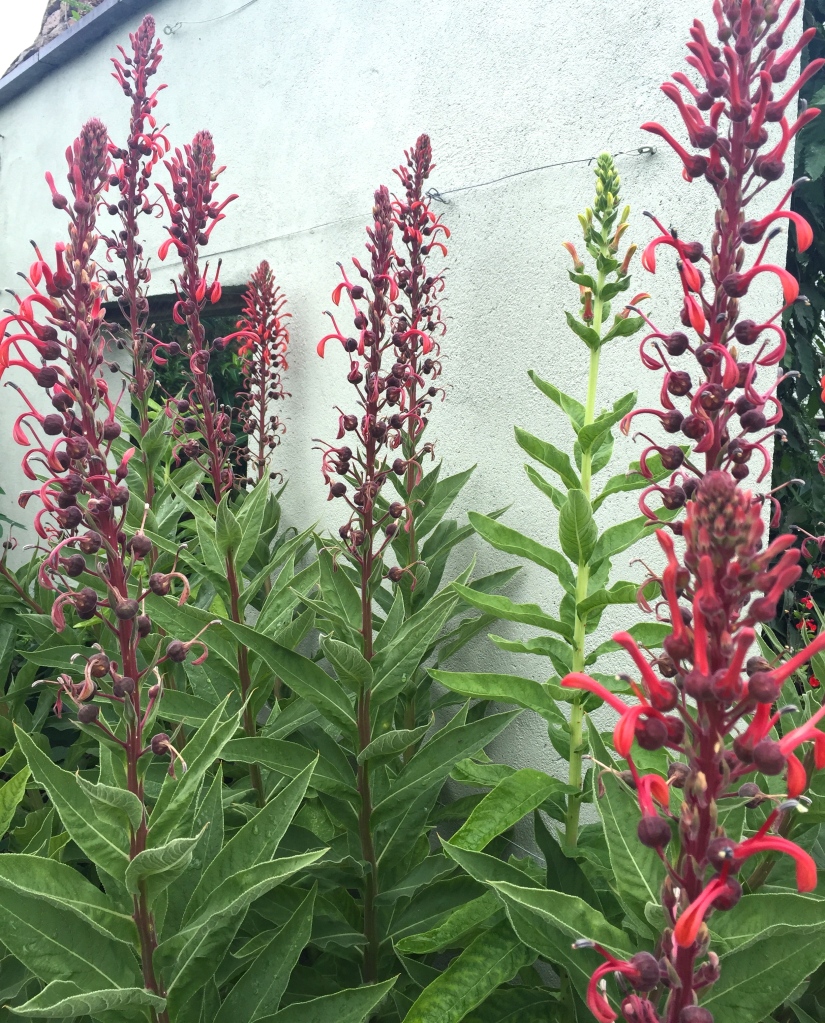 Lobelia tupa, Helen Dillon’s garden.
Lobelia tupa, Helen Dillon’s garden.
There are several very beautiful arching indigofera shrubs – I think this is Indigofera amblyantha which is a brilliant plant for lighting up the garden in late summer with very pretty slender racemes of pink pea like flowers.
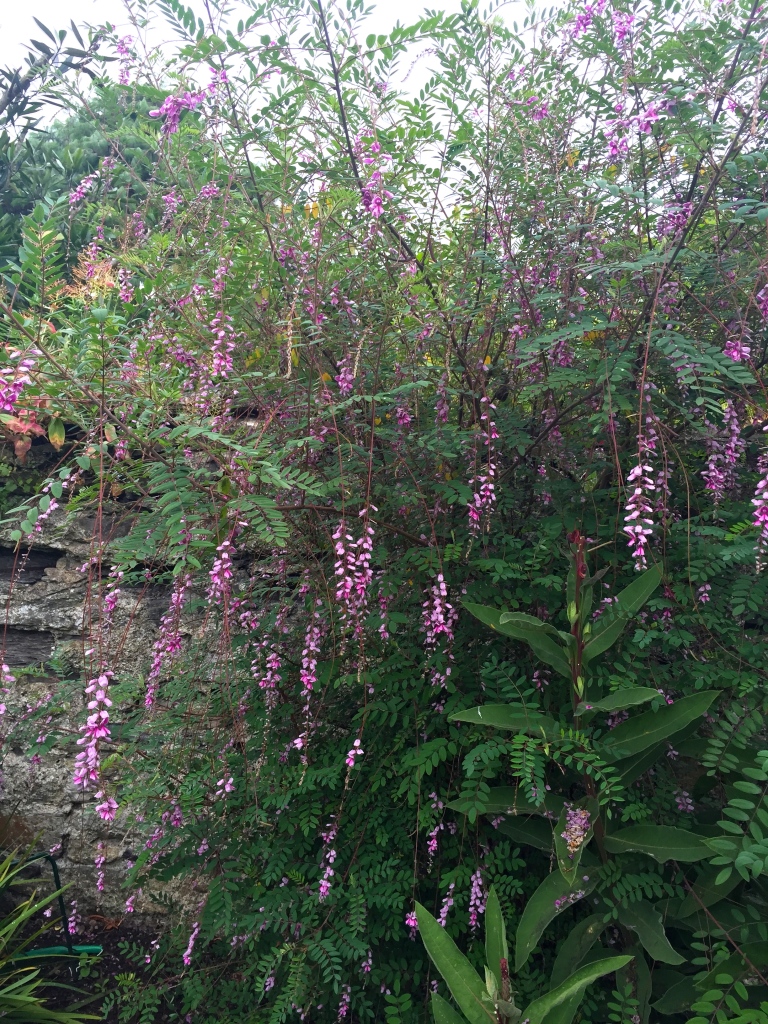
Indigofera amblyantha, Helen Dillon’s garden.
And there is a brilliant clump of racy greenish white flower heads of Veratrum album which has even more covetable leaves – like huge pleated hosta leaves – at its base:
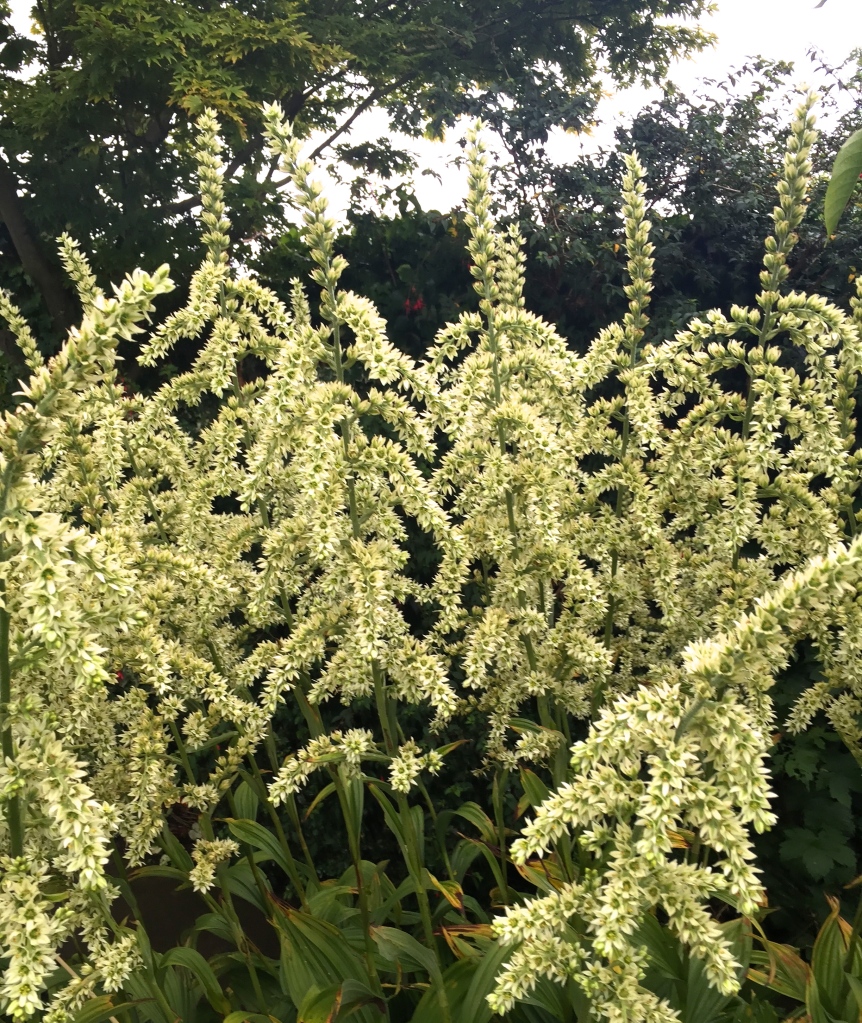 Veratrum album
Veratrum album
A really excellent combination of plants to create a lush, overspilling feel either side of a pathway is this group of Romneya coulteri (the California Tree Poppy), the evergreen shrub Bupleurum fruticosum (which has glowing clusters of lime green flowers) and a deep pink Japanese anemone. The bupleurum is one of those plants that you meet again and again, admire and never do anything about which is stupid as it is such an easy and handsome thing. I have long wanted Romneya coulteri, however, and planted one this spring in my Camberwell garden. I can’t quite work out yet if it likes me or not, it is notoriously picky and then if it does like you it is well known for being a bit unstoppable, but who could resist its abundance of huge papery flowers with yellow centres?


Romneya coulteri, Bupleurum fruticosum and deep pink Japanese anemone flank a path in Helen Dillon’s garden.
In this group of plants the fading rusty flower heads of Rodgersia pinnata ‘Perthshire Bronze’ are given a new energy by the coral red tapers of Persicaria amplexicaulis (possibly ‘Firetail’) and the rich pinks of the voluptuous lily.

Rodegersia pinnata ‘Perthshire Bronze’, Persicaria amplexicaulis and a voluptuous pink lily, Helen Dillon’s garden.
As I leave the fascinatingly neat flower heads, the shifting mauves and pinks and waxy green leaves of Hydrangea ‘Ayesha’ catch my eye. The hydrangea is in a pot and almost too good to be true. Naturally it goes immediately onto The List.
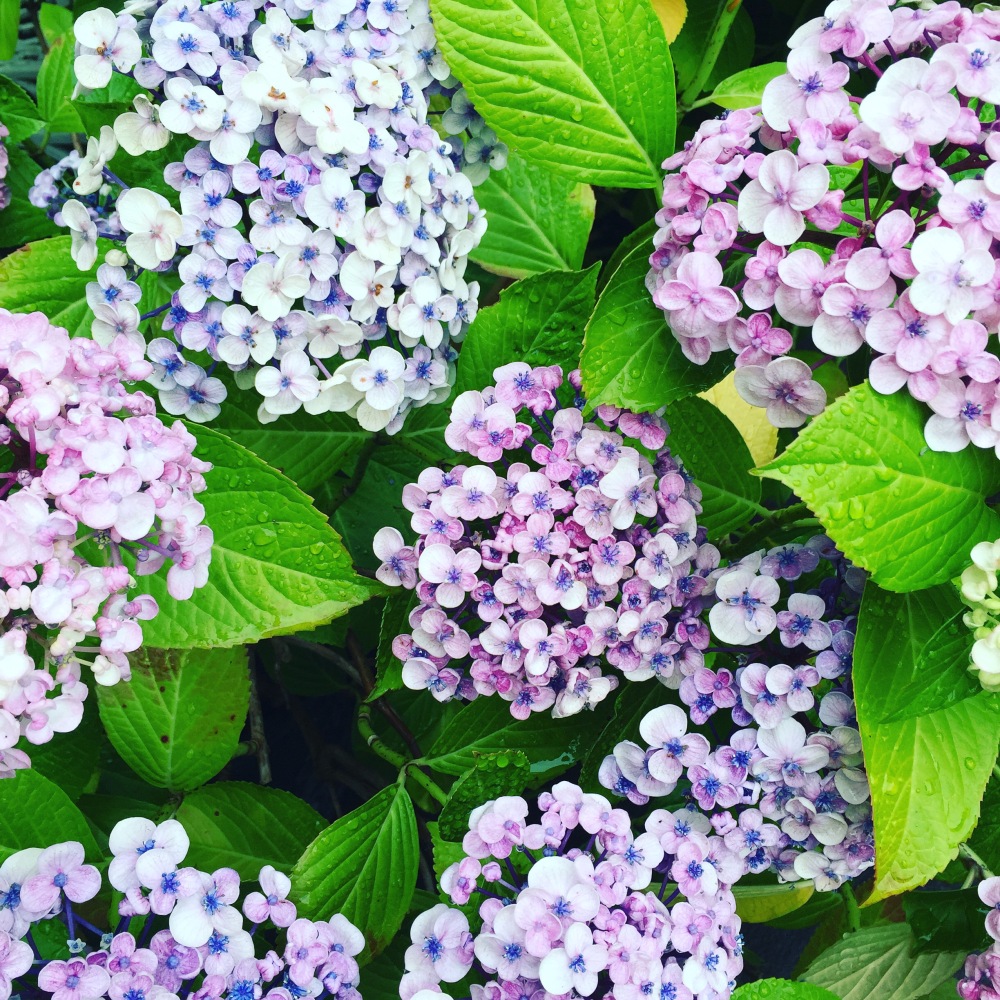 Hydrangea ‘Ayesha’, Helen Dillon’s garden.
Hydrangea ‘Ayesha’, Helen Dillon’s garden.
The front garden has been reorganised and replanted much more recently with a sandstone terrace and gently screening slim silver birch.

Helen Dillon’s house viewed from the street.
I am usually slightly allergic to silver birch as a solution tree for a contemporary look but I think it is a great choice here – not least as Helen Dillon has made sure to add texture and surprises in her effortlessly elegant way. I love the choice of the evergreen Itea ilicifolia over a side building: the shrub has glossy holly-like leaves and in late summer glamorous racemes of whitish-green, honey-scented flowers. The combination with a statuesque stand of Acanthus mollis and some crisp white Japanese anemone ‘Honorine Jobert’ is a handsome one.
 Itea ilicifolia, Acanthus mollis and Anemone x hybrida ‘Honorine Jobert’ in the front garden.
Itea ilicifolia, Acanthus mollis and Anemone x hybrida ‘Honorine Jobert’ in the front garden.
There is a lovely tumbling lightness to this group of Euphorbia characias, sea holly and some choice spiky leaves against the pale trunks of the birch (top photo) and below a huge stand of pink phlox is the plant that delightfully breaks the restrained palette of greens and white (below).

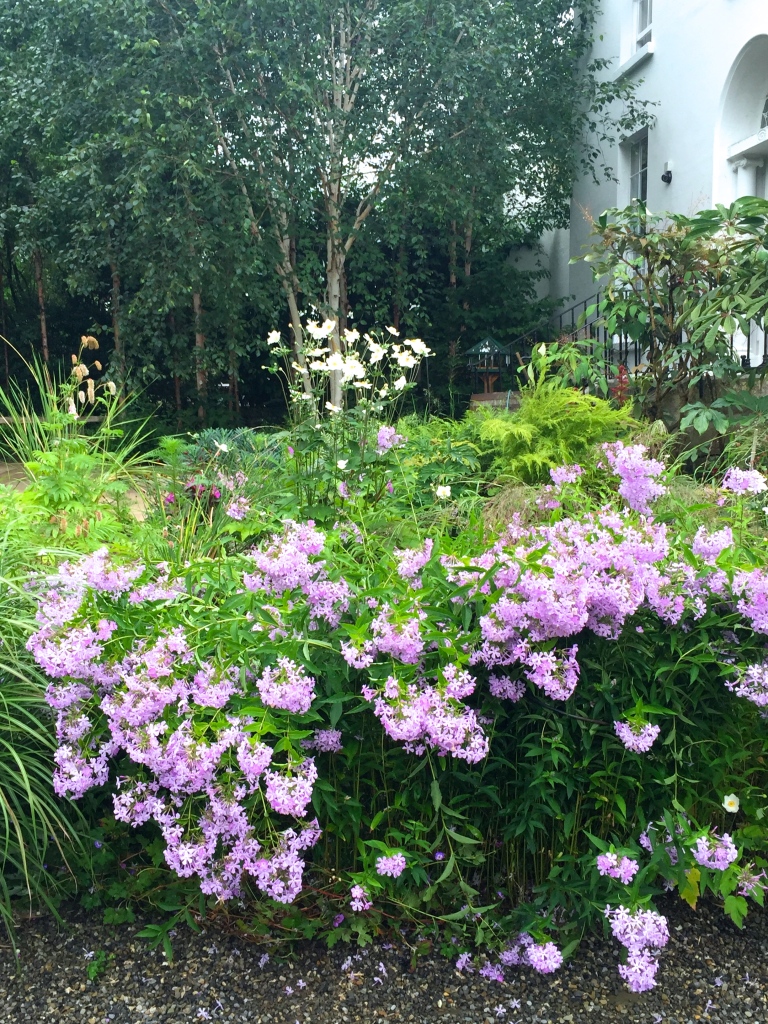
When I was eating my sandwich with Helen Dillon she was almost cross that there was such an intense outpouring of interest in her garden the moment she was leaving it. But I hope she has been enjoying the interest too and I for one am thrilled that it galvanised me to paying the garden a long-delayed visit.
I think Helen Dillon has made a very astute move, leaving now rather than slaving away, keeping a famous garden as perfect as it has always been in the magazines and lecture theatres. She says she is indeed very excited about the chance to start again. I thank her for wonderful enthusiasm, and for her brilliantly blunt, always entertaining writing that has taught so many of us so much. I have no doubt she will make another wonderful garden.
The one thing I could not have fitted into that miniature Skoda if I had tried is the fantastic oak bench that nestles against the silver birch trees in the front garden. I am smitten by the simplicity and stillness of the bench and the heavy, splayed triangle blocks that support it:
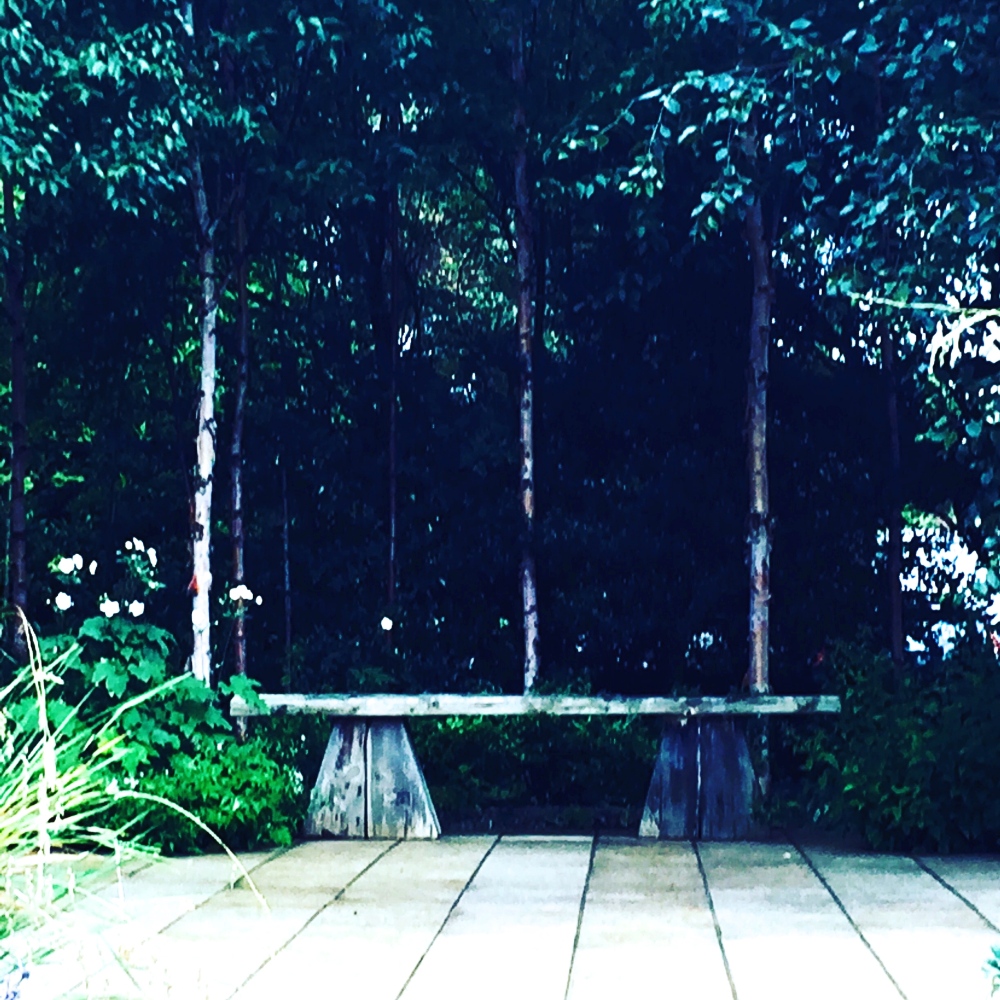
Simple, elegant (covetable) bench, Helen Dillon’s front garden.
